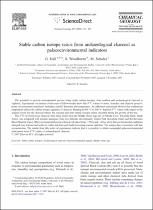 ResearchSpace
ResearchSpace
Stable carbon isotope ratios from archaeological charcoal as palaeoenvironmental indicators
JavaScript is disabled for your browser. Some features of this site may not work without it.
- ResearchSpace
- →
- Research Publications/Outputs
- →
- Journal Articles
- →
- View Item
| dc.contributor.author |
Hall, G

|
|
| dc.contributor.author |
Woodborne, SM

|
|
| dc.contributor.author |
Scholes, M

|
|
| dc.date.accessioned | 2008-05-21T13:54:57Z | |
| dc.date.available | 2008-05-21T13:54:57Z | |
| dc.date.issued | 2008-01 | |
| dc.identifier.citation | Hall, G, Woodborne, SM and Scholes, M. 2008. Stable carbon isotope ratios from archaeological charcoal as palaeoenvironmental indicators. Chemical Geology, Vol. 247(3-4), pp 384-400 | en |
| dc.identifier.issn | 0009-2541 | |
| dc.identifier.uri | http://hdl.handle.net/10204/2255 | |
| dc.description | Copyright: 2008 Elsevier Science B.V | en |
| dc.description.abstract | The potential to provide environmental proxies using stable carbon isotopes from modern and archaeological charcoal is explored. Experiments on modern Podocarpus (Yellowwoods) show that δ13C values of stems, branches and charcoal preserve proxy environmental conditions, including rainfall, humidity and temperature. An additional experiment showed that combustion temperature affects the carbon isotope signature of charcoal. Burning at 450 °C to 500 °C depletes δ13C values with respect to the original wood, but the charcoal retains the seasonal and inter-annual isotopic trends recorded during the growth of the tree. The δ13C of Podocarpus charcoal from three levels from the Middle Stone Age site of Sibudu Cave, KwaZulu-Natal, South Africa, was compared with modern analogues from two different environments, Seaton Park (KwaZulu-Natal) and the Baviaans Kloof (Eastern Cape). Other environmental proxies from levels dated from N70 ka and ~48 ka, show that environmental conditions changed from warmer and wetter to colder and drier and finally becoming warmer and drier. The isotope data is consistent with this reconstruction. The results from this series of experiments indicate that it is possible to obtain meaningful palaeoenvironmental information from δ13C values of archaeological charcoal | en |
| dc.language.iso | en | en |
| dc.publisher | Elsevier Science B.V | en |
| dc.subject | Archaeological charcoal | en |
| dc.subject | Palaeoenvironments | en |
| dc.subject | Carbon isotope ratios | en |
| dc.title | Stable carbon isotope ratios from archaeological charcoal as palaeoenvironmental indicators | en |
| dc.type | Article | en |
| dc.identifier.apacitation | Hall, G., Woodborne, S., & Scholes, M. (2008). Stable carbon isotope ratios from archaeological charcoal as palaeoenvironmental indicators. http://hdl.handle.net/10204/2255 | en_ZA |
| dc.identifier.chicagocitation | Hall, G, SM Woodborne, and M Scholes "Stable carbon isotope ratios from archaeological charcoal as palaeoenvironmental indicators." (2008) http://hdl.handle.net/10204/2255 | en_ZA |
| dc.identifier.vancouvercitation | Hall G, Woodborne S, Scholes M. Stable carbon isotope ratios from archaeological charcoal as palaeoenvironmental indicators. 2008; http://hdl.handle.net/10204/2255. | en_ZA |
| dc.identifier.ris | TY - Article AU - Hall, G AU - Woodborne, SM AU - Scholes, M AB - The potential to provide environmental proxies using stable carbon isotopes from modern and archaeological charcoal is explored. Experiments on modern Podocarpus (Yellowwoods) show that δ13C values of stems, branches and charcoal preserve proxy environmental conditions, including rainfall, humidity and temperature. An additional experiment showed that combustion temperature affects the carbon isotope signature of charcoal. Burning at 450 °C to 500 °C depletes δ13C values with respect to the original wood, but the charcoal retains the seasonal and inter-annual isotopic trends recorded during the growth of the tree. The δ13C of Podocarpus charcoal from three levels from the Middle Stone Age site of Sibudu Cave, KwaZulu-Natal, South Africa, was compared with modern analogues from two different environments, Seaton Park (KwaZulu-Natal) and the Baviaans Kloof (Eastern Cape). Other environmental proxies from levels dated from N70 ka and ~48 ka, show that environmental conditions changed from warmer and wetter to colder and drier and finally becoming warmer and drier. The isotope data is consistent with this reconstruction. The results from this series of experiments indicate that it is possible to obtain meaningful palaeoenvironmental information from δ13C values of archaeological charcoal DA - 2008-01 DB - ResearchSpace DP - CSIR KW - Archaeological charcoal KW - Palaeoenvironments KW - Carbon isotope ratios LK - https://researchspace.csir.co.za PY - 2008 SM - 0009-2541 T1 - Stable carbon isotope ratios from archaeological charcoal as palaeoenvironmental indicators TI - Stable carbon isotope ratios from archaeological charcoal as palaeoenvironmental indicators UR - http://hdl.handle.net/10204/2255 ER - | en_ZA |





